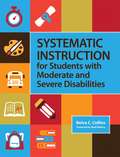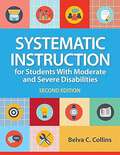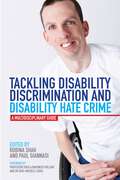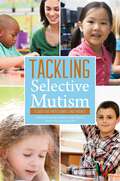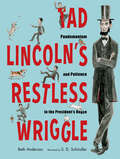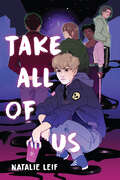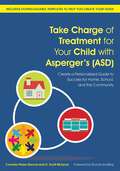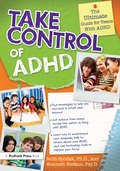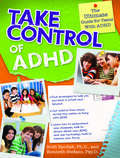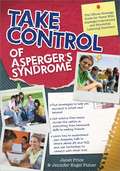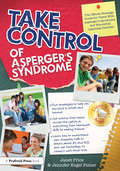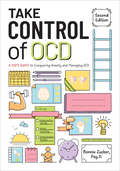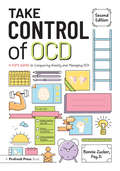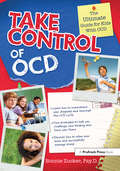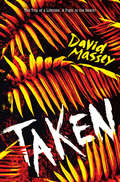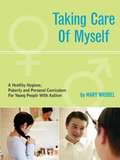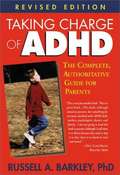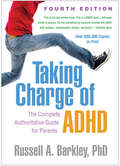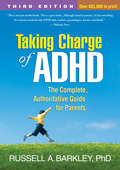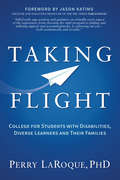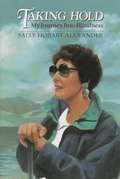- Table View
- List View
Systematic Instruction For Students With Moderate And Severe Disabilities
by Belva C. CollinsTo ensure the best outcomes for students with moderate and severe disabilities, K 12 educators need to understand what constitutes good instructional practices and how to apply them in any classroom, with any curriculum. All the how-to guidance they need is in this accessible text on systematic instruction, a highly effective teaching approach rooted in applied behavior analysis. Developed by a seasoned educator who has trained thousands of teachers, this one-of-a-kind textbook fully prepares teachers to use systematic instruction procedures to link core content with critical life skills. Future educators will discover evidence-based methods that help them collect accurate screening and baseline data before instruction effectively use specific systematic instruction procedures make instruction more efficient by weaving non-targeted information into lessons improve students' communication skills through naturalistic language strategies expertly organize and deliver small-group systematic instruction enhance instruction with assistive technology plan successful instructional schedules for students across settings and teachers maximize instruction time by involving peers, paraprofessionals, and service delivery personnel help students maintain new skills and generalize them to other settings An ideal textbook for a wide range of teacher preparation courses, this student-friendly book includes sample lesson plans, chapter objectives, reflection questions, and a glossary. And the practical materials including 20 blank data collection sheets and quick step-by-step charts of instruction procedures make this an invaluable resource for in-practice educators. A comprehensive guide to the why and how of systematic instruction, this is the accessible text teachers need to succeed in inclusive classrooms and improve outcomes for students with moderate and severe disabilities.
Systematic Instruction for Students with Moderate and Severe Disabilities
by Belva C. CollinsTo improve outcomes for students with moderate and severe disabilities, K–12 educators need to understand the why and how of good instructional practices. They’ll find comprehensive guidance in the second edition of this bestselling text on systematic instruction, a highly effective teaching approach rooted in applied behavior analysis (ABA).
Systematic Instruction of Functional Skills for Students and Adults with Disabilities
by Keith Storey Craig MinerA text on vocational guidance of individuals with disabilities.
Tackling Disability Discrimination and Disability Hate Crime: A Multidisciplinary Guide
by David Cain Syed Mohammed Naqvi Sylvia Lancaster Jemma Tyson Lord Nigel Crisp Sheila Hollins Phillipa Russell Nathan Hall Bob Munn Paul Giannasi Matt Houghton Paul Frederick Mark Brookes Catherine White Kathryn Stone Mike Smith Robina Shah Melanie GiannasiPlacing the experiences of victims at its heart, this book provides an authoritative overview of disability hate crime - explaining what it is, how it happens, its legal status, the impact on victims and how individuals and agencies should respond. The guide outlines innovative projects developed to address the problem, and provides tailored guidance for professionals spanning education, health and social care, and criminal justice. It also offers recommendations for effective multi-agency working. After highlighting the crimes committed against disabled people and society's failure to protect them, the book concludes with a powerful argument for cross-government action to improve professional practice and eliminate disability-motivated hate crime.
Tackling Selective Mutism: A Guide for Professionals and Parents
by Jean Gross Hilary M Cleator Carl Sutton Jyoti Sharma Miriam Jemmett Benita Rae Smith Rosemary Sage Maggie Johnson Jane Kay Alice Sluckin Keiko Kakuta Alison Wintgens Kate Jones Charlotte Firth Tony Cline Denise Lanes Victoria Roe Lindsay Whittington Johnston Susan David Bramble Geoffrey Gibson Nitza Katz-Bernstein Jenny PackerBringing together the latest research and understanding on selective mutism, this edited book gives essential information on the various treatment and therapy options. Experts in the fields of speech and language therapy, psychology, music therapy education and communication offer a wide range of professional perspectives on the condition, while case studies from people with selective mutism, past sufferers and parents reveal the personal impact. The book also clarifies what support a person with selective mutism is likely to need at home, school and in social situations. This definitive volume on selective mutism will be key reading for professionals such as speech and language therapists, educational psychologists, child psychiatrists, child and adolescent mental health workers and anyone working with selective mutism in therapeutic and educational settings, as well as family members wanting a closer understanding of what selective mutism is and how they can help.
Tad Lincoln's Restless Wriggle: Pandemonium and Patience in the President's House
by Beth AndersonBank Street College of Education Best Book of the YearTad Lincoln's restless wriggle just wouldn&’t quit, much to the delight of his father, President Abraham Lincoln—if not so much to anybody else! This picture book brings to life the famous first son who coped with a disability and other challenges while showing compassion, intelligence, and wisdom beyond his years. Tad Lincoln's boundless energy annoyed almost everyone but his father, President Abraham Lincoln. But Tad put that energy to good use during the tough times of the Civil War. Abraham Lincoln guided Tad's wriggle on visits to hospitals, to the telegraph office, and to army camps. Tad greeted visitors, raised money for bandages, and kept his father company late into the night. This special and patient bond between father and son was plain to see, and before long, Tad had wriggled his way into the hearts of others as well. Beth Anderson and S.D. Schindler follow Tad's antics during the Civil War to uncover the generous heart and joyful spirit that powered Tad's restless wriggle.
The Tail of Max the Mindless Dog: A Children's Book on Mindfulness
by Florenza LeeAs a puppy Max’s tail is oftentimes hurt.Believing his tail to be the source of his pain, he sets out to catch and tie it in a knot. This leads to Max developing a habit of running in circles.Will Max learn a new more productive habit or will life pass him by?ABOUT THE TAIL OF MAX THE MINDLESS DOG, A CHILDREN’S BOOK ON MINDFULNESSIncorporates the Belly Breath, count of ten, and words of affirmation Adult and child are guaranteed to love this book. Mindfulness.
Take All of Us
by Natalie LeifA YA unbury-your-gays horror in which an undead teen must find the boy he loves before he loses his mind and body.Five years ago, a parasite poisoned the water of Ian&’s West Virginia hometown, turning dozens of locals into dark-eyed, oil-dripping shells of their former selves. With chronic migraines and seizures limiting his physical abilities, Ian relies on his best friend and secret love Eric to mercy-kill any infected people they come across.Until a new health report about the contamination triggers a mandatory government evacuation, and Ian cracks his head in the rush. Used to hospitals and health scares, Ian always thought he'd die young... but he wasn&’t planning on coming back. Much less face the slow, painful realization that Eric left him behind to die.Desperate to find Eric and the truth before the parasite takes over him, Ian along with two others left behind—his old childhood rival Monica and the jaded prepper Angel—journey to track down Eric. What they don't know is that Eric is also looking for Ian, and he's determined to mercy-kill him.
Take Charge: A Strategic Guide for Blind Job Seekers
by Diane Croft Rami RabbyProvides guidance for blind job seekers.
Take Charge of Treatment for Your Child with Asperger's (ASD): Create a Personalized Guide to Success for Home, School, and the Community
by Shonda Schilling D. Scott Mcleod Cornelia Pelzer ElwoodEquipping you with the knowledge and tools to become an effective case manager for your child, this book provides straightforward, practical instructions to create a comprehensive guide to your child's unique ASD profile. The individualized guide will: - Provide information about your child's unique profile for anyone who needs it - Serve as a toolbox and teaching template for your child's teachers and support team, with effective strategies to use with him or her - Be an instruction booklet for your child, helping him or her to thrive at home, school and in the community - Act as a case management road map to help you support your child and collaborate with teachers and service providers. The book includes checklists and worksheets, which can also be accessed online, so that you can easily create a personalized guide for your child with autism aged 5-14.
Take Control of ADHD: The Ultimate Guide for Teens With ADHD
by Ruth Spodak Kenneth StefanoTake Control of ADHD: The Ultimate Guide for Teens With ADHD helps teens take control of their disorder and find success in school and in life. By creating the “ADHD Attention Profile” discussed in the book, readers will recognize how ADHD affects them, discover coping strategies and technology tools to improve their focus, and develop a self-advocacy plan they can use immediately. The book presents the latest research and information on ADHD in a conversational style that teens can understand easily, allowing them to develop a better understanding of their disorder. By including suggestions from teens with ADHD, the authors offer tons of advice, information, and ideas for students, from students just like them. This handy guidebook is sure to help teens with ADHD learn to refocus their attention and find success in school and beyond!Ages 12-18
Take Control of ADHD
by Ruth Spodak Kenneth StefanoTake Control of ADHD: The Ultimate Guide for Teens With ADHD is the ultimate handbook for teens with ADHD to help them take control of their disorder and find success in school and in life. By creating the "ADHD Action Plan" discussed in the book, readers will recognize how ADHD affects them, discover coping strategies and technology tools to improve their focus, and develop a self-advocacy plan they can use immediatelyThe book presents the latest research and information on ADHD in a conversational style that teens can understand easily, allowing them to develop a better understanding of their disorder. By including suggestions from teens with ADHD, the authors offer tons of advice, information, and ideas for students, from students just like them. This handy guidebook is sure to help teens with ADHD learn to refocus their attention and find success in school and beyond!
Take Control of Asperger's Syndrome: The Official Strategy Guide for Teens with Asperger's Syndrome and Nonverbal Learning Disorder
by Jennifer Engel Fisher Janet PriceTake Control of Asperger's Syndrome: The Official Strategy Guide for Teens With Asperger's Syndrome and Nonverbal Learning Disorder is a unique handbook for kids and teens on living successful lives with these disorders by taking control of their strengths to overcome their weaknesses. Drawing on their experiences as parents and teachers of students with Asperger's syndrome (AS) and Nonverbal Learning Disorders (NLD), the authors provide tips on understanding the disorders, living with the symptoms, succeeding in school, completing homework, talking to others about strengths and needs, making friends and socializing, and using technology to connect with other kids and teens with these disorders. By interviewing dozens of kids and teens who live with AS and NLD, the authors include ideas, information, and advice for students, by students just like them. This handy guidebook is sure to help any child or teen with AS or NLD navigate life's challenges with successful outcomes.
Take Control of Asperger's Syndrome: The Official Strategy Guide for Teens With Asperger's Syndrome and Nonverbal Learning Disorder
by Janet Price Jennifer Engel FisherA gifted education Legacy Award winner, Take Control of Asperger's Syndrome: The Official Strategy Guide for Teens With Asperger's Syndrome and Nonverbal Learning Disorder is a unique handbook for kids and teens on living successful lives with these disorders by taking control of their strengths to overcome their weaknesses.Drawing on their experiences as parents and teachers of students with Asperger's syndrome (AS) and Nonverbal Learning Disorder (NLD), the authors provide tips on understanding the disorders, living with the symptoms, succeeding in school, completing homework, talking to others about strengths and needs, making friends and socializing, and using technology to connect with other kids and teens with these disorders.By interviewing dozens of kids and teens who live with AS and NLD, the authors include ideas, information, and advice for students, by students just like them. This handy guidebook is sure to help any child or teen with AS or NLD navigate life's challenges with successful outcomes.Named one of the Pennsylvania State Librarians Assoication's Young Adult Top Forty nonfiction books of 2010.Ages 10-16
Take Control of OCD: A Kid's Guide to Conquering Anxiety and Managing OCD (Take Control Ser. #0)
by Bonnie ZuckerTake Control of OCD: A Kid's Guide to Conquering Anxiety and Managing OCD is a must-have guide for kids and teens ages 10–16 with obsessive-compulsive disorder to help them take control and use their strengths to find success in school and in life. This fully updated second edition:Uses a cognitive-behavioral therapy and exposure/response prevention method to stress gradual exposure to obsessive thinking patterns.Provides a step-by-step ladder-based process to help readers conquer their fears and demolish their worries.Helps kids change their obsessive thoughts, tolerate uncertainty, and develop positive self-talk and stress management.Also helps kids advocate for their needs in school and build successful relaxation procedures.Includes workbook-style pages for readers to complete.From her extensive work with hundreds of young people with OCD, the author offers tons of advice, information, and ideas for kids and teens. Readers will find themselves in this book, as it normalizes and validates the often hidden and undisclosed thoughts, urges, and images, and accompanying rituals and compulsions that so many children and teens with OCD struggle with.
Take Control of OCD: A Kid's Guide to Conquering Anxiety and Managing OCD
by Bonnie ZuckerTake Control of OCD: A Kid's Guide to Conquering Anxiety and Managing OCD is a must-have guide for kids and teens ages 10-16 with Obsessive-Compulsive Disorder to help them take control and use their strengths to find success in school and in life. This fully updated second edition:Uses a cognitive-behavioral therapy and exposure/response prevention method to stress gradual exposure to obsessive thinking patterns.Provides a step-by-step ladder-based process to help readers conquer their fears and demolish their worries.Helps kids change their obsessive thoughts, tolerate uncertainty, and develop positive self-talk and stress management.Also helps kids advocate for their needs in school and build successful relaxation procedures.Includes workbook-style pages for readers to complete.By interviewing kids with OCD from across the country, the author offers tons of advice, information, and ideas for students, by students just like them. Readers will find themselves in this book, as it normalizes and validates the often hidden and undisclosed thoughts, urges, and images, and accompanying rituals and compulsions that so many children and teens with OCD struggle with.Ages 10-16
Take Control of OCD: The Ultimate Guide for Kids With OCD (Take Control Ser. #0)
by Bonnie ZuckerTake Control of OCD: The Ultimate Guide for Kids With OCD is a unique guide just for kids ages 10-16 with Obsessive-Compulsive Disorder to help them take control of their disorder and find success in school and in life. Using a cognitive-behavioral therapy method to stress gradual exposure to students' obsessive thinking patterns, the book takes kids step-by-step through a ladder-based process to conquer their fears and demolish their worries.Focusing on helping kids change their obsessive thoughts, tolerate uncertainty, develop positive self-talk and stress management, advocate for their needs in school, find successful relaxation procedures, and face their fears, the book includes workbook-style pages for kids to complete. By interviewing kids with OCD from across the country, the author offers tons of advice, information, and ideas for students, by students just like them. This handy guidebook is sure to help children with OCD change their behaviors and conquer their worries, discovering a sense of accomplishment and achievement.Ages 10-16
Take Up Thy Bed and Walk: Death, Disability and Cure in Classic Fiction for Girls
by Lois KeithMany Victorian children's books written for girls show a lively, rebellious heroine who, by the end of the story, is tamed and ready to take on the role of submissive young woman. In a number of works, a temporary disability is the crucible which teaches these headstrong girls lessons in patience and humility. Sometimes goodness and will-power are rewarded with a miraculous cure. In other works a dying child serves as a lesson to the living, modeling endurance and faith. Lois Keith explores such themes in children's classics including Little Women, Heidi, The Secret Garden, and Pollyanna. In her final chapter she considers depictions of illness and disability and children's literature of the mid to late 20th century.
Taken
by David MasseyThe trip of a lifetime turns into a fight to the death when six extreme athletes are TAKEN hostage by pirates off the coast of Africa. By the author of TORN.Six crew members are toughing it out, trying to come together as a team to sail around the world on a grueling challenge for charity. Four are teen military veterans disabled in combat: They're used to being pushed to the limit. But nothing could have prepared them for being kidnapped by the Lord's Resistance Army. Suddenly, the trip of a lifetime turns into a dark journey into the African jungle. Taken hostage by a notorious warlord and his band of child soldiers, how will Rio, Ash, Marcus, Jen, Charis, and Izzy survive?
Taking Care of Myself: A Hygiene, Puberty, and Personal Curriculum for Young People with Autism
by Mary WrobelWinner of an iParenting Media Award! Puberty can be especially tough when young people have autism or other special needs. Through simple stories similar to Carol Gray's Social Stories, author Mary Wrobel teaches caregivers exactly what to say and not say, and shows how you can create helpful stories of your own. Mary addresses hygiene, modesty, body growth and development, menstruation, touching, personal safety, and more. Young students can benefit from self-care skills such as using the toilet, brushing teeth, and washing hands. Parents and teachers should begin teaching these necessary skills as early as possible, even from ages 3-5. The ultimate goal is to maximize the child's potential for independence and lifelong social success. Helpful sections include: Hygiene Health Modesty Growth and Development Menstruation Touching and Personal Safety Masturbation Using A Urinal
Taking Charge of ADHD: The Complete, Authoritative Guide for Parents (Revised Edition)
by Russell A. BarkleyEmpowers parents of children with ADHD by giving them a step-by-step plan for behavior management, hard data on diagnosis and treatment, strategies for helping children succeed at school and in social situations, and information on advances in genetic and neurological research that enhance understanding of the causes of ADHD. Includes an annotated list of books, organizations, and Internet resources. This edition is revised to incorporate the most current information. Barkley is director of psychology and professor of psychiatry and neurology at the University of Massachusetts Medical Center. Annotation c. Book News, Inc., Portland, OR (booknews.com)
Taking Charge of ADHD, Fourth Edition: The Complete, Authoritative Guide for Parents
by Russell A. BarkleyThe leading parent resource about attention-deficit/hyperactivity disorder (ADHD) and its treatment has now been revised and updated with the latest information and resources. Prominent authority Russell A. Barkley compassionately guides you to: *Understand why kids with ADHD act the way they do. *Get an accurate diagnosis. *Work with school and health care professionals to find needed support. *Implement a proven eight-step behavior management plan. *Build your child's academic and social skills. *Restore harmony at home. New to the fourth edition are a chapter on health risks associated with ADHD, the latest information on the causes of the disorder, current facts on medications, a new discussion of sibling issues, advice for parents who might have ADHD themselves, downloadable practical tools, and much more.
Taking Charge of ADHD, Third Edition
by Russell A. BarkleyFrom distinguished researcher/clinician Russell A. Barkley, this treasured parent resource gives you the science-based information you need about attention-deficit/hyperactivity disorder (ADHD) and its treatment. It also presents a proven eight-step behavior management plan specifically designed for 6- to 18-year-olds with ADHD. Offering encouragement, guidance, and loads of practical tips, Dr. Barkley helps you: *Make sense of your child's symptoms. *Get an accurate diagnosis. *Work with school and health care professionals to get needed support. *Learn parenting techniques that promote better behavior. *Strengthen your child's academic and social skills. *Use rewards and incentives effectively. *Restore harmony at home. Updated throughout with current research and resources, the third edition includes the latest facts about medications and about what causes (and doesn't cause) ADHD. See also Dr. Barkley's bestselling Taking Charge of Adult ADHD. Association for Behavioral and Cognitive Therapies (ABCT) Self-Help Book of Merit
Taking Flight: College for Students with Disabilities, Diverse Learners and Their Families
by Perry LaRoqueA learning differences expert shares stories, strategies, and information about what students with disabilities need to be successful in college. In Taking Flight, Dr. Perry T. Laroque shares his insight and expertise on a range of important issues many students with a wide range of disabilities face as they head off to college. Rather than merely focusing on the academic aspects, LaRoque addresses the full college experience, discussing the strategies and perspective needed to thrive in the classroom and beyond. With a mix of personal stories, humor, and frank advice, Perry T. LaRoque explores topics such as the concept of disability, the need for positive self-expression, college bureaucracy, roommate relationships, and having fun. Taking Flight addresses the truly relevant issues needed for happiness and success in college and teaches readers not only how to do well in the system, but how to overcome a system that isn&’t designed for today&’s diverse learners.
Taking Hold: My Journey into Blindness
by Sally Hobart AlexanderA true story of the author's loss of vision as a young woman and of her adaptation to blindness.
